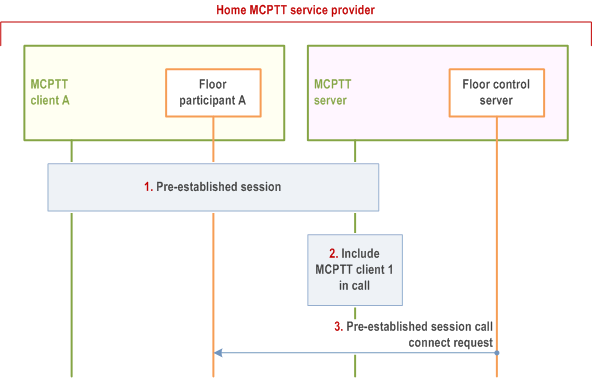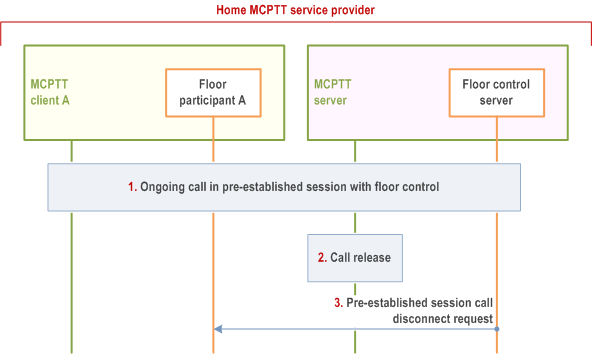Content for TS 23.379 Word version: 19.5.0
1…
7…
10…
10.5…
10.6…
10.6.2.3…
10.6.2.4…
10.6.2.5…
10.6.2.6…
10.6.2.9…
10.6.3…
10.7…
10.7.3…
10.7.5…
10.7.6…
10.9…
10.9.1.3.3…
10.9.1.4…
10.9.2…
10.10…
10.12…
10.19…
10.19.3…
10.19.3.1.4…
10.19.3.2…
10.19.3.2.4…
10.19.3.2.6…
A…
10.5 Pre-established session (on-network)
10.5.1 General
10.5.2 Information flows for pre-established session
10.5.3 Procedures
...
...
10.5 Pre-established session (on-network) p. 31
10.5.1 General p. 31
The MCPTT server and client may use one or more pre-established sessions as defined in TS 23.280 for the following procedures for on-network:
- Group calls (as specified in subclause 10.6.2.3 and subclause 10.6.2.4);
- Private calls (as specified in subclause 10.7.2.2 and subclause 10.7.2.3);
- MCPTT emergency group calls (as specified in subclause 10.6.2.6.1);
- MCPTT imminent peril group calls (as specified in subclause 10.6.2.6.2);
- MCPTT emergency private calls (as specified in subclause 10.7.2.4); and
- MCPTT emergency alerts (as specified in subclause 10.6.2.6.3).
10.5.2 Information flows for pre-established session p. 31
10.5.2.1 Pre-established session establishment p. 31
Table 10.5.2.1-1 describes the information flow create pre-established session request from the MCPTT client to the MCPTT server, for the procedure defined in TS 23.280.
| Information element | Status | Description |
|---|---|---|
| MCPTT ID of requester (originator) | M | This element identifies the MCPTT user that wishes to create a pre-established session. |
| SDP offer | M | SDP with media information offered by client (e.g. ports, codec, protocol id). |
Table 10.5.2.1-2 describes the information flow create pre-established session response from the MCPTT server to the MCPTT client, for the procedure defined in TS 23.280.
| Information element | Status | Description |
|---|---|---|
| SDP Answer | M | SDP with media information offered by server (e.g. ports, codec, protocol id). |
| Session ID | M | This element identifies the specific session ID used for pre-established sessions. |
10.5.2.2 Pre-established session modification p. 32
Table 10.5.2.2-1 describes the information flow modify pre-established session request from the MCPTT client to the MCPTT server, for the procedure defined in TS 23.280.
| Information element | Status | Description |
|---|---|---|
| MCPTT ID of requester (originator) | M | This element identifies the MCPTT user that wishes to create a pre-established session. |
| Session ID | M | This element identifies the specific session ID used for pre-established sessions. |
| SDP offer | M | SDP with media information offered by client (e.g. ports, codec, protocol id). |
Table 10.5.2.2-2 describes the information flow modify pre-established session response from the MCPTT server to the MCPTT client, for the procedure defined in TS 23.280.
| Information element | Status | Description |
|---|---|---|
| SDP Answer | M | SDP with media information offered by server (e.g. ports, codec, protocol id). |
| Session ID | M | This element identifies the specific session ID used for pre-established sessions. |
10.5.2.3 Pre-established session release - client initiated p. 32
Table 10.5.2.3-1 describes the information flow release pre-established session request from the MCPTT client to the MCPTT server, for the procedure defined in TS 23.280.
| Information element | Status | Description |
|---|---|---|
| MCPTT ID of requester (originator) | M | This element identifies the MCPTT user that wishes to release a pre-established session. |
| Session ID | M | This element identifies the specific session ID used for pre-established sessions. |
| Release reason | M | This element indicates that reason for the session release. |
Table 10.5.2.3-2 describes the information flow release pre-established session response from the MCPTT server to the MCPTT client, for the procedure defined in TS 23.280.
| Information element | Status | Description |
|---|---|---|
| Session ID | M | This element identifies the specific session ID used for pre-established sessions. |
10.5.2.4 Pre-established session release - server initiated p. 33
Table 10.5.2.4-1 describes the information flow release pre-established session request from the MCPTT server to the MCPTT client, for the procedure defined in TS 23.280.
| Information element | Status | Description |
|---|---|---|
| MCPTT ID of target | M | This element identifies the MCPTT user that is the target of the for pre-established session release. |
| Session ID | M | This element identifies the specific session ID used for pre-established sessions. |
| Release reason | M | This element indicates the reason for the session release. |
Table 10.5.2.4-2 describes the information flow release pre-established session response from the MCPTT client to the MCPTT server, for the procedure defined in TS 23.280.
| Information element | Status | Description |
|---|---|---|
| Session ID | M | This element identifies the specific session ID used for pre-established sessions. |
10.5.2.5 Pre-established session call connect request p. 33
Table 10.5.2.5-1 describes the information flow pre-established session call connect request from the MCPTT server to the MCPTT client, for the procedure defined in subclause 10.5.3.2.1 of the present document.
| Information element | Status | Description |
|---|---|---|
| MCPTT group ID | O | Identity of the MCPTT group (see NOTE). |
| MCPTT ID | O | MCPTT ID of the private call MCPTT user (see NOTE). |
| Session ID | M | This element identifies the specific session ID used for pre-established sessions. |
|
NOTE:
Depending on type of connection either MCPTT group ID or MCPTT ID shall be present.
|
||
10.5.2.6 Pre-established session call disconnect request p. 33
Table 10.5.2.6-1 describes the information flow pre-established session call disconnect request from the MCPTT server to the MCPTT client, for the procedure defined in subclause 10.5.3.2.2 of the present document.
| Information element | Status | Description |
|---|---|---|
| MCPTT group ID | O | Identity of the MCPTT group (see NOTE). |
| MCPTT ID | O | MCPTT ID of the private call MCPTT user (see NOTE). |
| Session ID | M | This element identifies the specific session ID used for pre-established sessions. |
| Reason code | O | Information about call disconnect reason. |
|
NOTE:
Depending on type of connection either MCPTT group ID or MCPTT ID shall be present.
|
||
10.5.3 Procedures p. 34
10.5.3.1 General p. 34
The MCPTT server and MCPTT client make use of the procedures defined in the following subclauses of the present document and the following procedures in TS 23.280:
- pre-established session establishment;
- pre-established session modification; and
- pre-established session release.
10.5.3.2 Call connect and disconnect procedures using pre-established session p. 34
10.5.3.2.1 Call connect over unicast p. 34
Call connect and disconnect information flows are sent over non-SIP media plane signalling using MCPTT-4 for including or releasing an MCPTT client in the call using a pre-established session.
Figure 10.5.3.2.1-1 shows the high level procedure where a call connect information flow is sent by the MCPTT server to inform MCPTT client(s) using a pre-established session that the MCPTT client(s) has/have been connected to an MCPTT private call or group call.

Step 1.
Pre-established session exists between MCPTT client A and MCPTT server.
Step 2.
MCPTT server has determined to include MCPTT client A in the call e.g., upon receiving the request from another MCPTT client to include MCPTT client A in the call.
Step 3.
Pre-established session call connect request information flow is sent by the MCPTT server to inform MCPTT client A using a pre-established session that it has been connected to MCPTT private or group call. The floor control is established between floor participant A and floor control server.
10.5.3.2.2 Call disconnect over unicast p. 35
Figure 10.5.3.2.2-1 shows the high level procedure where a disconnect information flow is sent by the MCPTT server to the MCPTT client A to indicate that the MCPTT private call or group call using a pre-established session has been released.

Step 1.
Floor control is ongoing within a private or group call established using pre-established session.
Step 2.
MCPTT server has determined to release MCPTT client A from the call e.g., due to call release.
Step 3.
Pre-established session call disconnect request message is sent by the MCPTT server to indicate to MCPTT client A that the MCPTT private call or group call using a pre-established session has been released. MCPTT server may include a Reason code parameter to indicate additional information to the MCPTT client about the call disconnect reason. Pre-established session between MCPTT client A and MCPTT server remains for further use.